
* The Northrop F-89 Scorpion all-weather interceptor was nothing great for looks, and never fired a shot in anger. However, for much of the 1950s it was the backbone of the US Air Force's defense of the United States, and was produced in quantity. This document provides a history and description of the F-89 Scorpion.
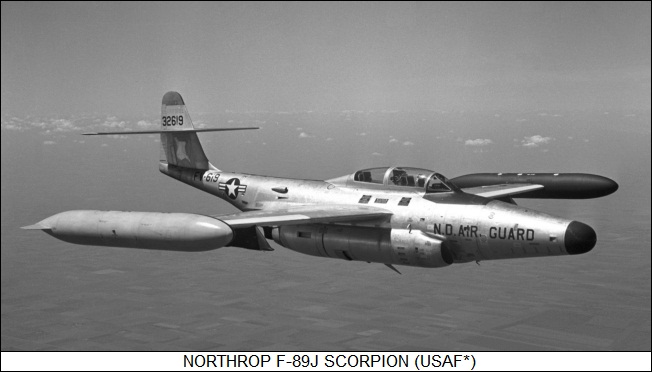
* In December 1945, the US Army Air Forces (USAAF) issued a request for a jet-propelled night fighter to replace the Northrop P-61 Black Widow. Eight aircraft manufacturers responded the request, with the USAAF selecting two finalists: the Curtiss "XP-87 Blackhawk" and the "Northrop N-24". The USAAF also evaluated the Douglas "XF3D Skyknight" for the requirement.
Curtiss received a contract for a small lot of Nighthawks, though as it turned out the contract would be canceled in 1948 after the flight of a single prototype; the Skyknight was also given the thumbs down, though the Navy and Marines would make good use of it into the Vietnam War. The USAAF settled on the Northrop N-24, signing a development contract with Northrop in the spring of 1946, leading to the manufacture of two prototypes. The first prototype, the "XP-89", flew on 16 August 1948 from Muroc Air Force Base, now Edwards AFB, with Northrop test pilot Fred Belcher at the controls. The XP-89 was painted all black and had a high tail, and so it was named the "Scorpion".
The Scorpion was a hefty aircraft, with a straight mid-mounted wing with a narrow height to chord ratio. The tailplane was mounted halfway up the swept tailplane. Control surface arrangement was conventional, including ailerons, double slotted flaps, elevators, and rudder. The Scorpion had distinctive main gear with large but narrow tires on a wide track that retracted into the thin wing, the gear hinging inward towards the fuselage. The prototype was powered by two Allison J35-A-13 axial-flow turbojets, each offering 16.7 kN (1,700 kgp / 3,750 lbf) thrust. That was too little thrust for too much aircraft.
The pilot and radar operator sat in tandem in a pressurized cockpit, under a canopy that slid back to open. Removeable wingtip fuel tanks with a capacity of 1,158 liters (300 US gallons) were added early in 1949. An airborne-intercept (AI) radar and cannons were to be fitted in the nose, though they were not installed in the prototype. After its initial series of flights, the prototype was fitted with "decelerons", which were ailerons split to open up above and below the wings and act as dive brakes.
* The second prototype, designated "XF-89A", first flew on 15 November 1949. It was substantially redesigned, much closer to production spec, with a more pointed nose and uprated Allison J35-A-21 engines with afterburners, offering 21.8 kN (2,220 kgp / 4,900 lbf) thrust dry and 30.2 kN (3,080 kgp / 6,800 lbf) thrust in afterburner. The engine nacelles were substantially redesigned, with auxiliary inlet doors on the lower front side to provide more airflow for take-off and so on, and the wingtip tanks were permanently mounted.
The XF-89A wasn't armed, though it did have AN/ARC-33 radar in the nose, coupled to a Hughes E-1 fire control system (FCS). It featured a natural metal finish, instead of the black finish of the first prototype, which crashed on 22 February 1950 due to a tail flutter problem, one of the two aircrew being killed. The crash led to serious doubts about the viability of the Scorpion program, but Northrop proved able to resolve problems, and so the F-89 survived. The tail flutter issue was resolved initially by the modification of the engine exhausts -- the exhaust flow having set up instabilities over the tailplane -- and the addition of external "mass balances" on the elevator to damp out oscillations.
BACK_TO_TOP* The USAF (the Army Air Forces became the Air Force in 1947) was pleased with the Scorpion and ordered a batch of 48 aircraft in July 1949. The first of this batch, the "YF-89A", flew on 25 September 1950, leading to the production "F-89A". The F-89A was much like the XF-89A, even retaining the Allison J35-A-21 engines. The major difference was that the F-89A was armed, featuring six T-31 20-millimeter cannon in the nose with 200 rounds per gun, the cannons being staggered to permit ammunition feed clearance. The YF-89A also had underwing provision for bombs or up to 16 unguided rockets -- the Air Force envisioned the Scorpion as having a secondary attack role, though it would never be assigned to the attack mission in practice. The F-89A was left in natural metal finish, except for anti-glare black patterns where needed.
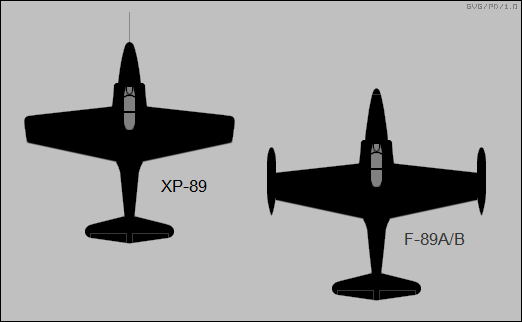
F-89As began to flow to US Air Defense Command and Alaska Air Command units in 1952, though the Scorpion demonstrated an alarming accident rate at first. This problem was not exclusive to the F-89 at the time; the Air Force had been rushing new high-performance aircraft into production, resulting in many technical glitches and pilot training problems, with lethal results. There were crashes at least once a week in that timeframe, with scores of aircrew killed.
Only eight F-89As were actually delivered, the aircraft basically amounting to an evaluation variant. They would end up in test and trials, some ultimately being converted to target drones with the designation of "DF-89A". Production moved on to the "F-89B", which featured minor avionics systems updates, such as a Lear-Siegler autopilot. 40 F-89Bs were built, with initial deliveries in 1951, and most F-89As were rebuilt to F-89B standards. They were withdrawn from frontline service in 1954, to serve with the US Air National Guard (USANG) for a few years, though the F-89Bs were never very satisfactory.
* The "F-89C" was the first Scorpion variant really suitable for operational service, with 164 built. The F-89C featured a balanced elevator that got rid of the cluttered external mass balances and many other small tweaks -- later F-89C production including engine inlet screens that were retracted along with the landing gear. The screens were added because the Scorpion's low-mounted engines had such an alarming tendency to ingest rocks and other debris kicked up by the nosewheel that the aircraft was sometimes referred to as the "F-89 Flying Hoover Vacuum Cleaner".
The first 34 F-89Cs retained the J35-A-21 engine, while the next 30 had the similar but much more reliable -21A engine. However, the next 45 F-89Cs built had J35-A-33 engines, with 24 kN (2,450 kgp / 5,400 lbf) dry thrust and 33 kN (3,360 kgp / 7,400 lbf) thrust in afterburner, while the last 55 built were fitted with the -33A, with 24.9 kN (2,540 kgp / 5,600 lbf) dry thrust but the same afterburning thrust as the -33. Armament and radar remained unchanged from the F-89B.
In 1952, six Scorpions, mostly F-89Cs, crashed -- one doing so in front of a crowd at an airshow -- and the fleet was grounded. The problem was traced to a wing design fault, with all Scorpions in service then rotated through a modification program to fit stronger wings, as well as a fin on the end of each wingtip tank to reduce stress on the wing. Once the wings were fixed, the Scorpion's accident rate fell dramatically and the type would then acquire a good flight safety record. By the time the F-89Cs were withdrawn from frontline service in 1954, all had been re-engined with J35-A-47 engines, the thrust levels being similar to those of the -33A but with many technical refinements. The F-89Cs served faithfully with the USANG into the 1960s.
* It should be noted before continuing that trials performed by these early Scorpions included some unusual armament configurations. One F-89A was fitted with an odd nose turret with four aimable 20-millimeter cannon. Under Project GUN-VAL, two F-89Cs were fitted with four 30-millimeter Oerlikon cannon each, and one F-89C was fitted with twin rocket guns that fired Mighty Mouse rockets, each launcher being fed by a magazine with 25 rockets. The rockets were fired by an explosive charge and then ignited their rocket engine after clearing the aircraft.
BACK_TO_TOP* The reason for the withdrawal of the F-89B/C variants in 1954 was the introduction of the "F-89D" variant, the definitive Scorpion. The initial YF-89D prototype, a modified F-89B, had performed its first flight on 23 October 1951. The guns were deleted, the interceptor being armed with 104 Mighty Mouse 70-millimeter (2.75-inch) unguided folding-fin air rockets (FFAR), carried in the front of the wingtip fuel tanks, each tank with a capacity of 1,166 liters (308 US gallons).
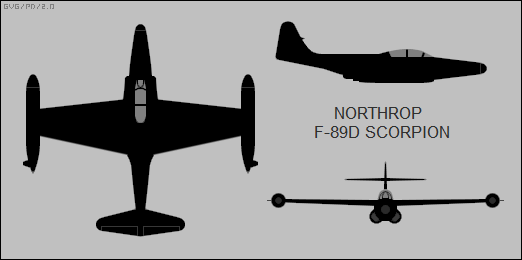
The rockets were directed by the new Hughes E-6 FCS system and its AN/APG-40 radar, the E-6 automatically directing the Scorpion towards its target to an optimum firing position. The E-6 in principle permitted "collision-course intercepts", with the Scorpion approaching the target from its forward quadrant and firing rockets to destroy it as the paths of the two aircraft intersected. In a more traditional "tail chase" attack, the interceptor would line up behind the target for shots, but in a collision-course intercept there was effectively only one chance to get it right. That was why the unguided rockets were used: although they were notoriously inaccurate, it seemed likely that if a salvo was launched against a target the size of a bomber, one rocket would hit, and that would be enough to take the target down. Rockets could be launched in one, two, or three salvos, either manually or under the automatic direction of the fire-control system. Vents around the rear of the rocket pack diverted the exhaust from the fuel tank behind it; launching the rockets was spectacular to watch.
The F-89D also featured additional fuel tankage in the nose, replacing the guns, and could carry a 760-liter (200 US gallon) drop tank under each wing. A total of 682 F-89Ds was built, initially with Allison J35-A-33A engines, with later production and upgrades moving through improved engine variants up to the J35-A-47.
___________________________________________________________________
NORTHROP F-89D SCORPION:
___________________________________________________________________
wingspan:
18.2 meters (59 feet 8 inches)
wing area:
52.21 sq_meters (562 sq_feet )
length:
16.4 meters (53 feet 10 inches)
height:
5.36 meters (17 feet 7 inches)
empty weight:
11,400 kilograms (25,200 pounds)
max loaded weight:
19,160 kilograms (42,240 pounds)
maximum speed:
960 KPH (600 MPH / 520 KT)
service ceiling:
15,000 meters (49,200 feet)
range with tanks:
2,200 KM (1,370 MI / 1,190 NMI)
___________________________________________________________________
The F-89D featured complicated avionics systems that demanded a lot of maintenance -- but that was the rule for sophisticated 1950s electronics. Any equivalent aircraft would have had the same issue, pilots of the era commenting that, unlike 21st century combat aircraft, "all systems go" was the exception and not the rule.
A few F-89Ds ended up in Northrop service as target drone launchers, carrying Northrop / Radioplane rocket-powered target drones for training crews of US Army Nike surface-to-air missile (SAM) sites. These "JF-89D" drone launchers served in that role into the late 1960s.
* The single "YF-89E" was an F-89C fitted as an engine-test prototype with Allison YJ71-A-3 turbojets providing 43.1 kN (4,400 kgp / 9,700 lbf) thrust each. Though the J71s were well more powerful than the F-89D's J35 engines, they did not significantly improve performance -- clearly the Scorpion had reached the limits imposed by its aerodynamics. The F-89E with the J71 engines was abandoned, but the designation was resurrected for a different design, a single-seat long-range escort fighter with twin GE J47 turbojets, like those used on the Boeing B-47 bomber, with 40.5 kN (4,125 kgp / 9,100 lbf) thrust each; a modified, more aerodynamically efficient wing to take advantage of the greater thrust provided by the J47s; and a pod in the middle of each wing with 54 FFARs, the main gear retracting into the pods. It retained the nose cannon.
The F-89E didn't happen, with Northrop moving on to the further refined "F-89F" concept, also with J47 turbojets; a spine fairing from the cockpit to the tailfin for additional fuel storage; a further refined wing and a reconfigured tail assembly; and larger midwing pods, with rockets, main gear, and fuel. Cannon armament was deleted. Two-seat and single-seat variants were considered -- but as tends to happen to an aircraft when a lot of "more" is added to it, weight creep gradually exceeded the thrust capability of the J47 powerplants, and the project was abandoned.
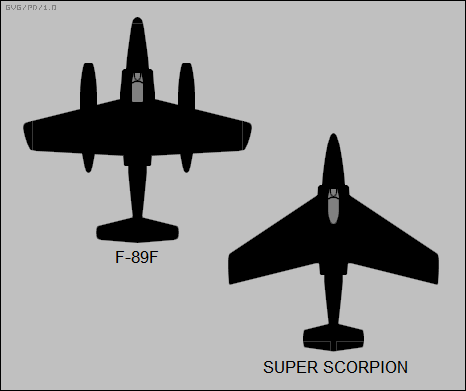
It should be noted here that a swept-wing Scorpion was also considered, this machine being known as the "Super Scorpion", once again with both two-seat and single-seat configurations considered. It never got off the drawing board.
* The "F-89G" was an advanced interceptor variant that was given up as too ambitious, with attention then turned to the more conservative "F-89H", the last production Scorpion. It was an updated F-89D, with primary armament updated to the Falcon air-to-air missile (AAM). Falcon variants are something of a confusing issue, there having been a series of heat-seeking weapons and a series of "semi-active radar homing (SARH)" weapons that homed in on the reflections of the Scorpion's radar off a target. To make matters more confusing, in 1962 the US military adopted a multiservice designation scheme and all the Falcon designations were shuffled around in a not very intuitive fashion:
In any case, the F-89H could carry up to twelve Falcons, with three in the nose of each wingtip pod, plus pylons for a total of six Falcons under the wings. Generally, only the six Falcons in the wingtip pods were carried, with three being SARH variants and three being heat-seeking variants. The idea was to launch both a SARH and a heat-seeking Falcon at a target on the basis if that if one didn't work, the other might.
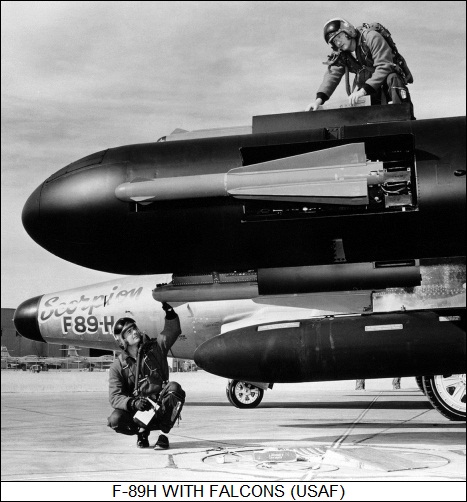
The Falcons in the wingtip pods were on rotating launch racks, with the missiles stored inside the pod until they were popped out for launch. The original idea was to fire the Falcons out of slots in the front of the pods, but trials showed that approach didn't work very well. The pods could still carry 21 unguided rockets each, in three banks of seven rockets with each bank between two Falcons. The F-89H was fitted with J35-A-35 engines initially, being updated in service to later variants, and the Hughes E-9 FCS to support the Falcons. Total production of the F-89H was 156 aircraft, in addition to three F-89Ds modified as prototypes.
* 350 F-89Ds were updated beginning in 1956 to the "F-89J" spec. This variant featured stores pylons under the wings for two unguided Douglas MB-1 / AIR-2A Genie rockets -- AKA "Ding Dong", the Genie having a definitely phallic appearance -- with nuclear warheads, plus four Falcons, though the Falcons weren't generally carried in practice. While some F-89Js retained the wingtip fuel and rocket pods of the F-89D, most were refitted with simple wingtip fuel pods. The F-89J was equipped with a Hughes MG-12 FCS system to handle the Genie. The Genie was simply fired in the general direction of the target, being detonated at the appropriate time by the MG-12 FCS; the lethal blast radius, about 300 meters (1,000 feet), was big enough to ensure destruction of the target.
It was another, likely more effective, approach to ensuring destruction of a target -- even an entire bomber formation -- in a collision-course intercept. The Genie's powerful rocket motor allowed a Scorpion to attack an intruder moving at high speed at a substantially higher altitude. However, with improvements in guided AAMs, the Genie would become obsolescent, and enthusiasm for nukes eventually faded out of air defense. They were just too troublesome to handle, and the fact that use of a nuke in any context would have required approval from the White House made them effectively useless. Even at the peak of "nuclear insanity", there were plenty who were skeptical of the idea of spreading nukes to hundreds of installations and making security a nightmare, not to mention relying on nukes as a standard military doctrine.
In 1963, ten F-89Js were modified as piloted "targets" of a sort, having their radar removed, to be replaced by ballast, and fitted with underwing tanks. These "DF-89J" machines were flown by USAF pilots to probe US Army Nike surface-to-air missile defenses in Japan. Another F-89J was fitted with test kit to be used in angle of attack trials at Edwards AFB.
BACK_TO_TOP* A total of 1,052 Scorpions of all types was built. It was never exported and the Air Force, plus its auxiliary components, were the sole operators. The table below gives variants and production:
The F-89 was the mainstay of North American air defense during the 1950s; it was a sturdy, pedestrian aircraft, a "missile truck", a true interceptor and not really a fighter. It never saw any combat. It was gradually withdrawn from front-line service later in the decade, being replaced by the Convair F-102 Delta Dart. However, Scorpions served with Air Force Reserve and Air National Guard units until as late as 1969. The F-89 had a surprisingly long service life, impressive for a machine that was more or less a first-generation combat jet.
* From the early 1950s Northrop considered a supersonic successor, originally starting with a F-89 with a delta wing and moving from there, initially to the "N-126" -- a tailed-delta design, with an afterburning engine under each wing and bicycle-type landing gear. The only major thing it owed to the Scorpion was the F-89H's E-9A fire control system.
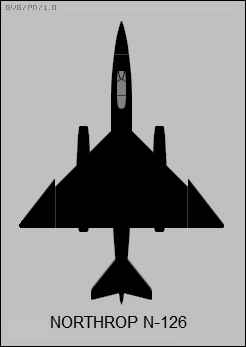
The N-126 concept then led to the "N-144", essentially the same configuration but scaled up, with twin engines in a pod under each wing. Northrop also considered the "N-149", not quite as big a scale-up from the N-126, with twin, more powerful engines. Nothing came of these ideas; US aircraft manufacturers generated a dizzying array of designs for advanced interceptors through the 1950s and into the 1960s, but the F-106 turned out to be the solution the USAF settled on and kept. It seems that the quest for a more potent interceptor was driven by the potential threat of high-speed Soviet jet bombers; from the late 1950s, however, long-range missiles became the strategic strike platform of choice, rendering the race between manned bomber and interceptor less irrelevant.
BACK_TO_TOP* The loser in the Air Force competition that produced the Scorpion, the XF-87 Blackhawk, had a few distinctions of its own. It was one of the few fighters ever fitted with four engines, and it was the last fighter ever made by Curtiss.
The Blackhawk evolved out of studies performed during the war by Curtiss for a twin engine, jet powered ground attack aircraft designated the XA-43. In November 1945, the project was redefined into the Blackhawk all weather interceptor. After long delays in development, the XF-87 Blackhawk took to the air at Muroc on 1 March 1948. The Blackhawk was a big aircraft for a fighter, with a length of 19.15 meters (62 feet 10 inches), a wingspan of 18.3 meters (60 feet), a height of 6.1 meters (20 feet), an empty weight of 11,760 kilograms (25,930 pounds), and a fully loaded weight of 22,635 kilograms (49,900 pounds).
The Blackhawk featured straight mid-mounted wings and tricycle landing gear. It was a two-seat aircraft, with the flight crew sitting in side-by-side under a bubble canopy, and was powered by four Westinghouse XJ34-WE-7 turbojets, with 13.3 kN (1,360 kgp / 3,000 lbf) of thrust each, fitted in pairs in nacelles mounted under the middle of each wing. Four turbojets were required because of the low thrust offered by the engines available at the time. The aircraft was to be fitted with four 20-millimeter cannon in a swiveling nose turret installation, like that evaluated on the F-89A.
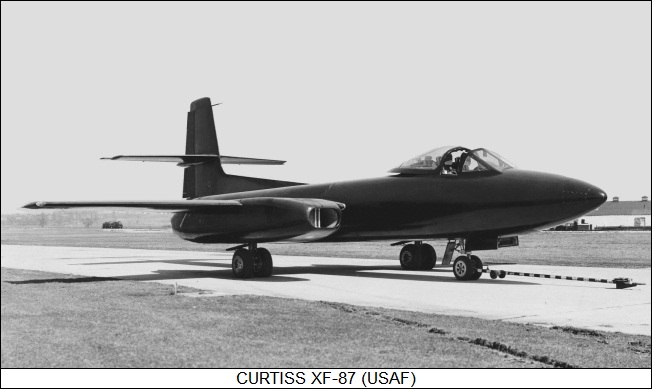
The Blackhawk was arguably a very elegant aircraft, but flight evaluation of the prototype showed it to be underpowered. However, more powerful engines were available at that time, and Curtiss proposed replacing the four XJ34 engines with two General Electric J47-GE-7 turbojets with 26.7 kN (2,720 kgp / 6,000 lbf) thrust each.
___________________________________________________________________
CURTISS XF-87 BLACKHAWK:
___________________________________________________________________
wingspan:
18.29 meters (60 feet)
wing area:
55.74 sq_meters (600 sq_feet)
length:
19.15 meters (62 feet 10 inches)
height:
6.1 meters (20 feet)
empty weight:
11,762 kilograms (25,930 pounds)
MTO weight:
22,635 kilograms (49,900 pounds)
max speed at altitude:
965 KPH (600 MPH / 520 KT)
service ceiling:
12,500 meters (41,000 feet)
range:
1,620 kilometers (1,000 MI / 870 NMI)
___________________________________________________________________
The Air Force was interested, ordering 57 F-87A interceptors and 30 RF-87A reconnaissance aircraft. Unfortunately for Curtiss, although flight tests of the XF-87 helped iron out bugs and the aircraft seemed promising, in the face of limited resources the Air Force was forced to put all the money on the F-89. All orders for the Blackhawk were canceled on 1 October 1948.
Curtiss tried to promote an attack variant with twin turboprops, but nobody bit. The XF-87 four-engine prototype was the only Curtiss Blackhawk to ever fly. Curtiss had once been a leader in American aviation, but the company culture had fallen apart by World War II, the firm churning out aircraft that were mediocre, like the P-40; or bug-ridden, like the C-46; or just plain nightmares to get right, like the SB2C Helldiver. The Blackhawk was one of the last gasps of breath of a dying giant.
BACK_TO_TOP* During the 1950s, for reasons described above, standard doctrine for the USAF was to arm interceptors with loads of unguided FFAR rockets. They were known to be inaccurate, with the usual comment of those who worked with the rockets being: "It was a wonder they could hit anything with them." One true tale of the Scorpion is particularly educational in this regard.
On 16 August 1956, a Grumman F6F-5K Hellcat target drone was sent aloft from the Point Mugu Naval Air Station, in southern California up the Pacific coast from Los Angeles. The Hellcat had been one of the great US Navy fighters of the Second World War, but by the 1950s it had been reduced to the status of a target, painted red and flying under radio control.
Or at least, this Hellcat was supposed to be flying under radio control. Although the range area was over the Pacific, the Hellcat decided to head towards Los Angeles instead. Nobody wanted the unpiloted aircraft to crash into a school or whatever, so two US Air Force F-89Ds were scrambled from Oxnard Air Force Base, not far from Point Mugu, to destroy the wandering drone. The two F-89Ds carried a total of 208 FFARs in all.
The Hellcat actually passed over Los Angeles; of course, shooting it down over the city would have been lunacy, so the interceptor crews could only hold their breath and wait for the drone to fly clear. It finally decided to orbit over the town of Santa Paula, where the interceptor crews tried to get opportunities to take a shot at it. They were using automatic fire-control mode, but the fire-control system malfunctioned and they didn't get a single rocket off.
Then the Hellcat decided to meander for a time, eventually turning back towards Los Angeles. The Scorpion crews switched to manual fire control and loosed salvos of rockets at the drone. The rockets missed the Hellcat, falling to the ground to start a raging brush fire. The Scorpion crews tried again, with no better luck, starting two more brush fires -- one of them fueled by oil rigs in the unintended target area.
Finally, as the drone headed toward Palmdale, the Scorpions fired their last rockets at it. They missed again. This time, the rockets fell into the town of Palmdale. A piece of shrapnel smashed through the living-room window of one house, passing through a wall to end up in a cupboard. Another fragment passed through a garage and home. A car's front end was shredded when a rocket fell in front of it. Astoundingly, nobody was hurt. Explosive ordnance disposal teams from Edwards Air Force Base picked up 13 dud rockets from around Palmdale. It took hundreds of firefighters two days to put out the three brush fires, after the blazes had consumed hundreds of acres.
The Hellcat finally wandered over the Mojave Desert near Palmdale, where it ran out of fuel, falling to earth in an uninhabited area but cutting three power lines doing it. By the records, the incident seems to have attracted little public attention.
* I know the F-89 well, as the Air National Guard operated it from Geiger Field near Spokane when I was little. I still have fairly clear memories of watching the high-tailed Scorpions zooming overhead; in fact, it was likely the first aircraft I was ever able to recognize.
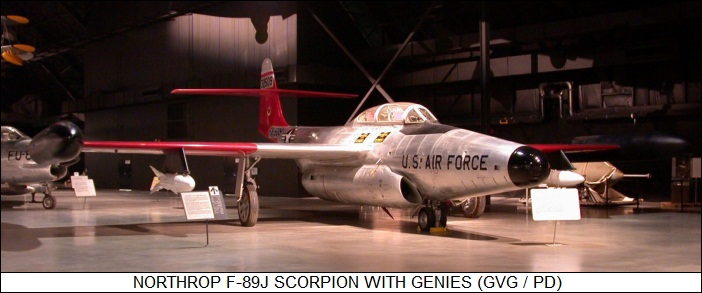
* Sources include:
* Revision history:
v1.0.0 / 01 nov 12 v1.0.1 / 01 oct 14 / Review & polish. v1.0.2 / 01 sep 16 / Review & polish. v1.0.3 / 01 aug 18 / Review & polish. v1.0.4 / 01 jun 20 / Review & polish. v1.0.5 / 01 jun 25 / Review & polish. (*)BACK_TO_TOP
